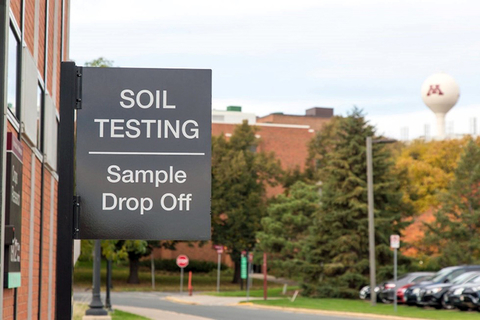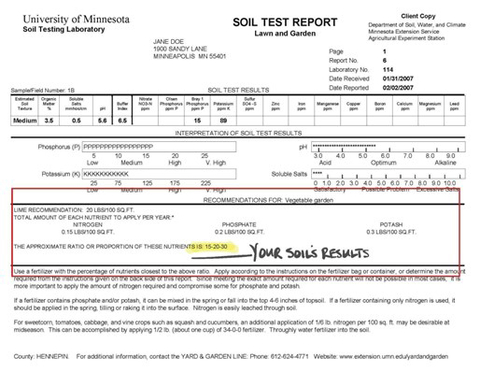We typically think of soil testing in the spring when we are preparing our gardens and yards for planting. While the University of Minnesota Soil Testing Lab staff work hard to return results within two weeks, more tests mean results can take longer — sometimes up to three weeks during the spring rush.
Keith Piotrowski, research manager of the Soil Testing Lab, recommends fall soil testing. The lab has a smaller backlog of samples to test, the results are just as accurate, and you can be ready for planting as soon as the soil thaws. Fall soils can be drier than spring soil and not frozen, so digging a good sample is easier. A basic soil test costs $19.
A healthy garden starts with healthy soil and the results of a lab test provide key information:
- Texture, which helps determine drainage
- Organic matter
- Soil pH
- Phosphorus and potassium levels
- Fertilizer recommendations
You can also add on tests for soluble salts and lead for additional charges.
Why take a soil test?
Soil tests provide a snapshot of your soil’s current nutrient levels, helping you to make smart decisions about whether to apply compost, manure or fertilizer and how much to apply.
The three main nutrients that plants require for healthy growth are nitrogen (N), phosphorus (P), and potassium (K). Although they are already present in your soil to some degree, your N-P-K levels may not be optimal for plant growth. Your soil might lack potassium, for example, or you might have more than enough phosphorus already. The goal is to make sure your plants are the most productive they can be without applying too many nutrients, which can lead to environmental issues.
“If you're growing tomatoes, you want the most tomatoes per plant; the healthiest, the best tasting. If you're growing flowers, you want the prettiest flowers. If you're growing turf, you want the healthiest turf,” explains Piotrowski. “By having a soil test done, you can get a snapshot of the nutrient status of your garden or lawn. It’s a good way to check and make sure that there are sufficient nutrients there for optimal growth.”
How to take a soil test
The soil sampling process itself is quite straightforward. The Soil Testing Lab’s Lawn and Garden webpage is the best place to begin. There, you can download the Lawn and Garden Soil Analysis Request Sheet. This form walks you through how to take a soil sample and how to submit samples to the lab. You can also pick up this form, as well as soil sample collection bags, from your local U of M Extension office. This short video shows you exactly how to take a soil test from your garden:
Once you have submitted your sample to the lab, it takes about two weeks to receive your results. The Soil Lab tests about 6,000 samples every year from the public. Most samples are from home growers and gardeners, but the lab also tests soils for researchers from all over the country.
The regular soil test is sufficient for most lawns and gardens. But you can also test for soluble salts, lead, and trace elements (sulfur, micronutrients, etc.). High soluble salt levels can be bad for plant health and yield while exposure to lead in soil is a health concern for humans, especially young children and pregnant adults. Trace elements are important for some crops. These tests require additional fees (see the request sheet for more information).
Understanding your soil test report
Your soil test report provides your soil’s N-P-K levels, as well as organic matter content, pH level, and estimated texture. For most home growers, the lab’s N-P-K results provide enough direction to begin to amend your soil.
Watch a short video on how to interpret your soil test results.
Still have questions?
See Managing Soil and Nutrients in Yards and Gardens for helpful resources and videos on how to collect soil samples and how to interpret your results.
Don’t hesitate to reach out to your local Extension educator for help. You also can Ask a Master Gardener to get research-based answers to your specific questions. Extension's Yard and Garden pages can help you identify and solve problems with your plants with our growing and watering guides.



